Fragilaria longwania sp. nov. (Bacillariophyceae), a New Araphid Diatom from Sihailongwan Maar Lake, Northeastern China
Abstract
1. Introduction
2. Materials and Methods
2.1. Study Site
2.2. Hydrochemistry of Lake Sihailongwan
2.3. Diatom Sampling and Sample Preparation
3. Results
3.1. New Species Description
3.2. Analysis of the Trap Samples
3.3. Analysis of Additional Samples
| Date | Sample | Dominant Species | % Fragilaria longwania |
|---|---|---|---|
| From 19 May 2003 to 15 July 2017 | Sediment trap samples (center of the lake, −45 m water depth), (n =187) | Discostella stelligeroides (43.3, 0.4–92.0%), Lindavia balatonis (26.2, 1.7–76.3%) 1 | 2.1 (0–19.8%) 1 |
| 26 April 2005 | Epilithon (small stones, near shore, <0.5 m depth) | Lindavia balatonis (19.3%), Achnanthidium sieminskae (16.0%), Encyonopsis perborealis (7.6%), Discostella stelligeroides (5.9%), Encyonema silesiacum (5.0%) | Not observed |
| 21 October 2005 | Surface-sediment (−50 m water depth, lake center) | Discostella stelligeroides (57.2%), Lindavia balatonis (17.6%), Pseudostaurosira parasitoides (3.2%), Nanofrustulum trainorii (2.2%), Fragilaria pectinalis (1.9%) | 1.8% |
| 18 November 2006 | Periphyton on floating buoy (lake center) | Achnanthidium sieminskae (50.6%), Brachysira neoexilis (15.2%), Encyonopsis subminuta (7.2%), Staurosirella ovata (5.9%), Discostella stelligeroides (4.6%) | 3.0% |
| 19 November 2006 | Epilithon (small stones, near shore, <0.5 m depth) | Nitzschia cf sociabilis (12.6%), Achnanthidium sieminskae (9.6%), Lindavia balatonis (9.1%), Nitzschia archibaldii (7.8%), Tabellaria hercynica (7.4%) | 2.6% |
| 19 November 2006 | Epiphyton (−10 m water depth, filamentous green) | Discostella stelligeroides (18.7%), Lindavia balatonis (9.6%), Pseudostaurosira pseudoconstruens (8.7%), Staurosirella ovata (6.5%), Sellaphora chistiakovae (3.0%) | 1.3% |
| 19 November 2006 | Epipelon (−17 m water depth) | Discostella stelligeroides (32.0%), Staurosirella ovata (15.4%), Lindavia balatonis (10.6%), Pseudostaurosira parasitoides (5.9%), Staurosira longwanensis (5.9%) | 1.2% |
| 14 August 2007 | Surface-sediment (−51 m water depth, lake center) | Discostella stelligeroides (80.4%), Lindavia balatonis (6.3%), Fragilaria longwania (1.2%) | 1.2% |
| 22 April 2008 | Periphyton on floating buoy (lake center) | Achnanthidium sieminskae (38.5%), Discostella stelligeroides (16.3%) Brachysira neoexilis (14.4%), Encyonopsis perborealis (4.4%), Lindavia balatonis (3.0%) | 0.4% |
| 22 April 2008 | Epilithon (small stones, near shore, <0.5 m depth) | Encyonopsis perborealis (23.6%), Encyonema silesiacum (14.6%), Discostella stelligeroides (12.2%), Lindavia balatonis (10.6%), Achnanthidium sieminskae (8.9) | Present (<0.1%) |
| 3 August 2016 | Periphyton on floating buoy (lake center) | Achnanthidium sieminskae (27.5%), Encyonopsis perborealis (19.0%), Lindavia balatonis (14.2%), Eucocconeis laevis (13.3%), Rossithidium pusillum (7.3%) | Not observed |
| 3 August 2016 | Epilithon (small stones, near shore, <0.5 m depth) | Encyonopsis perborealis (29.3%), Achnanthidium sieminskae (9.30%), Lindavia balatonis (8.7%), Achnanthidium sp cf duriense (8.0%), Nitzschia lacuum (6.0%) | 1.3% |
| 3 August 2016 | Epixylon (dead tree, near shore, <0.5 m depth) | Encyonopsis perborealis (32.8%), Achnanthidium sieminskae (18.0%), Lindavia balatonis (14.8%), Nitzschia gessneri (6.9%), Brachysira neoexilis (4.8%) | Not observed |
4. Discussion
4.1. Generic Placement of the New Species
4.2. Comparison with Other Species of the Genus Fragilaria
4.3. Ecology, Seasonality, Cell-Size and Distribution
Supplementary Materials
Author Contributions
Funding
Data Availability Statement
Acknowledgments
Conflicts of Interest
Abbreviations
| SEM | Scanning Electron Microscopy |
| LM | Light Microscopy |
References
- Lyngbye, H.C. Tentamen Hydrophytologiae Danicae Continens Omnia Hydrophyta Cryptogama Daniae, Holsatiae, Faeroae, Islandiae, Groenlandiae Hucusque Cognita, Systematice Disposita, Descripta et Iconibus Illustrata, Adjectis Simul Speciebus Norvegicis; Hafniae [Copenhagen]: Typis Schultzianis, in Commissis Librariae Gyldendaliae; Forgotten Books: London, UK, 1819; p. 70. [Google Scholar] [CrossRef]
- Van de Vijver, B.; Williams, D.M.; Kelly, M.; Jarlman, A.; Wetzel, C.E.; Ector, L. Analysis of some species resembling Fragilaria capucina (Fragilariaceae, Bacillariophyta). Fottea 2021, 21, 128–151. [Google Scholar] [CrossRef]
- Van de Vijver, B.; Williams, D.M.; Schuster, T.M.; Kusber, W.-H.; Cantonati, M.; Wetzel, C.E.; Ector, L. Analysis of the Fragilaria rumpens complex (Fragilariaceae, Bacillariophyta) with the description of two new species. Fottea 2022, 22, 93–121. [Google Scholar] [CrossRef]
- Van de Vijver, B.; Williams, D.M.; Kusber, W.-H.; Cantonati, M.; Hamilton, P.B.; Wetzel, C.E.; Ector, L. Fragilaria radians (Kützing) D.M. Williams et Round, the correct name for F. gracilis (Fragilariaceae, Bacillariophyta): A critical analysis of this species complex in Europe. Fottea 2022, 22, 256–291. [Google Scholar] [CrossRef]
- Van de Vijver, B.; Schuster, T.M.; Jónsson, G.S.; Hansen, I.; Williams, D.M.; Kusber, W.-H.; Wetzel, C.E.; Ector, L. A critical analysis of the Fragilaria vaucheriae complex (Bacillariophyta) in Europe. Fottea 2023, 23, 62–96. [Google Scholar] [CrossRef]
- Wang, Q.; Liu, Y.; Kociolek, J.P.; You, Q.; Fan, Y.; Qi, Y. Freshwater Diatom Families and Genera of China; Science Press: Beijing, China, 2025; p. 328. (In Chinese) [Google Scholar]
- Kociolek, J.P.; You, Q.; Liu, Q.; Liu, Y.; Wang, Q. Continental diatom biodiversity discovery and description in China: 1848 through 2019. PhytoKeys 2020, 160, 45–97. [Google Scholar] [CrossRef]
- Rioual, P.; Flower, R.J.; Chu, G.; Lu, Y.; Zhang, Z.; Zhu, B.; Yang, X. Observations on a fragilarioid diatom found in inter-dune lakes of the Badain Jaran Desert (Inner Mongolia, China), with a discussion on the newly erected genus Williamsella Graeff, Kociolek & Rushforth. Phytotaxa 2017, 329, 28–50. [Google Scholar] [CrossRef]
- Krahn, K.J.; Schwarz, A.; Wetzel, C.E.; Cohuo-Durán, S.; Daut, G.; Macario-González, L.; Pérez, L.; Wang, J.; Schwalb, A. Three new needle-shaped Fragilaria species from Central America and the Tibetan Plateau. Phytotaxa 2021, 479, 1–22. [Google Scholar] [CrossRef]
- Luo, F.; You, Q.; Yu, P.; Wang, Q. Diatoms in the Hengduan Mountains, China; Shanghai Science and Technology Press: Shanghai, China, 2024; p. 584. (In Chinese) [Google Scholar]
- Liu, Q.; Glushenko, A.; Kulikovskiy, M.; Maltsev, Y.; Kociolek, J.P. New Hannaea Patrick (Fragilariaceae, Bacillariophyta) species from Asia, with comments on the biogeography of the genus. Cryptogam. Algol. 2019, 40, 41–61. [Google Scholar] [CrossRef]
- Luo, F.; You, Q.; Zhang, L.; Yu, P.; Pang, W.; Bixby, R.J.; Wang, Q. Three new species of the diatom genus Hannaea Patrick (Bacillariophyta) from the Hengduan Mountains, China, with notes on Hannaea diversity in the region. Diatom Res. 2021, 36, 23–36. [Google Scholar] [CrossRef]
- Liu, B. The diatom genus Ulnaria (Bacillariophyceae) in China. PhytoKeys 2023, 228, 1–118. [Google Scholar] [CrossRef] [PubMed]
- Mingram, J.; Stebich, M.; Schettler, G.; Hu, Y.; Rioual, P.; Nowaczyk, N.; Dulski, P.; You, H.; Opitz, S.; Liu, Q.; et al. Millennial-scale East Asian monsoon variability of the last glacial deduced from annually laminated sediments from Lake Sihailongwan, N.E. China. Quat. Sci. Rev. 2018, 201, 57–76. [Google Scholar] [CrossRef]
- Chu, G.; Liu, J.; Schettler, G.; Li, J.; Sun, Q.; Gu, Z.; Lu, H.; Liu, Q.; Liu, T. Sediment fluxes and varve formation in Sihailongwan, a maar lake from northeastern China. J. Paleolimnol. 2005, 34, 311–324. [Google Scholar] [CrossRef]
- Schettler, G.; Liu, Q.; Mingram, J.; Negendank, J.F.W. Palaeovariations in the East-Asian monsoon regime geochemically recorded in varved sediments of Lake Sihailongwan (Northeast China, Jilin Province). Part 1: Hydrological conditions and dust flux. J. Paleolimnol. 2006, 35, 239–270. [Google Scholar] [CrossRef]
- Han, Y.; An, Z.; Lei, D.; Zhou, W.; Zhang, L.; Zhao, X.; Yan, D.; Arimoto, R.; Rose, N.L.; Roberts, S.L.; et al. The Sihailongwan Maar Lake, northeastern China as a candidate Global Boundary Stratotype Section and point for the Anthropocene Series. Anthr. Rev. 2023, 10, 177–200. [Google Scholar] [CrossRef]
- Rioual, P.; Lu, Y.; Yang, H.; Scuderi, L.; Chu, G.; Holmes, J.; Zhu, B.; Yang, X. Diatom-environment relationships and a transfer function for conductivity in lakes of the Badain Jaran Desert, Inner Mongolia, China. J. Paleolimnol. 2014, 50, 207–229. [Google Scholar] [CrossRef]
- Håkanson, L.; Floderus, S.; Wallin, M. Sediment trap assemblages—A methodological description. Hydrobiologia 1989, 176, 481–490. [Google Scholar] [CrossRef]
- Kirchner, W.B. An evaluation of sediment trap methodology. Limnol. Oceanogr. 1975, 20, 657–660. [Google Scholar] [CrossRef]
- Battarbee, R.W.; Jones, V.J.; Flower, R.J.; Cameron, N.G.; Bennion, H.; Carvalho, L.R.; Juggins, S. Diatoms. In Tracking Environmental Change Using Lake Sediments; Smol, J.P., Birks, H.J.B., Last, W.M., Eds.; Volume 3: Terrestrial, Algal, and Siliceous Indicators; Kluwer Academic Publishers: Dordrecht, The Netherlands, 2001; pp. 155–202. [Google Scholar] [CrossRef]
- Battarbee, R.W.; Kneen, M.J. The use of electronically counted microspheres in absolute diatom analysis. Limnol. Oceanogr. 1982, 27, 184–188. [Google Scholar] [CrossRef]
- Round, F.E.; Crawford, R.M.; Mann, D.G. The Diatoms: Biology and Morphology of the Genera; Cambridge University Press: Cambridge, UK, 1990; p. 747. [Google Scholar]
- Silva, P.C. Classification of algae. In Physiology and Biochemistry of Algae; Lewin, R.A., Ed.; Academic Press: New York, NY, USA; London, UK, 1962; pp. 827–837. [Google Scholar]
- Greville, R.K. Div. IV. Diatomaceae. In The English Flora of Sir James Edward Smith; Hooker, W.J., Ed.; Class XXIV; Cryptogamia. Vol. V. (or Vol. II of Dr. Hooker’s British Flora); Part I; Comprising the Mosses, Hepaticae, Lichens, Characeae and Algae; Longman, Brown, Green & Longmans Paternoster-Row: London, UK, 1833; pp. 401–415. [Google Scholar]
- Rioual, P.; Morales, E.A.; Chu, G.; Han, J.; Li, D.; Liu, J.; Liu, Q.; Mingram, J.; Ector, L. Staurosira longwanensis sp. nov., a new araphid diatom (Bacillariophyta) from Northeast China. Fottea 2014, 14, 91–100. [Google Scholar] [CrossRef]
- Dubois, A. Describing new species. Taprobanica 2010, 2, 6–24. [Google Scholar] [CrossRef]
- Williams, D.M. Spines and homologues in ‘araphid’ diatoms. Plant Ecol. Evol. 2019, 152, 150–162. [Google Scholar] [CrossRef]
- Graeff, C.L.; Kociolek, J.P.; Rushforth, S.R. New and interesting diatoms (Bacillariophyta) from Blue Lake Warm Springs, Tooele County, Utah. Phytotaxa 2013, 153, 1–38. [Google Scholar] [CrossRef]
- Al-Handal, A.Y.; Kociolek, J.P.; Abdullah, D.S. Williamsella iraqiensis sp. nov., a new diatom (Bacillariophyta, Fragilariophyceae) from Sawa lake, South Iraq. Phytotaxa 2016, 244, 289–297. [Google Scholar] [CrossRef]
- Lange-Bertalot, H.; Metzeltin, D. Indicators of Oligotrophy — 800 Taxa Representative of Three Ecologically Distinct Lake Types: Carbonate Buffered—Oligodystrophic—Weakly Buffered Soft Water; Lange-Bertalot, H., Ed.; Volume 2 of Iconographia Diatomologica; Koeltz Scientific Books: Königstein, Germany, 1996; p. 390. [Google Scholar]
- Wengrat, S.; Morales, E.A.; Wetzel, C.E.; Almeida, P.D.; Ector, L.; Bicudo, D.C. Taxonomy and ecology of Fragilaria billingsii sp. nov. and analysis of type material of Synedra rumpens var. fusa (Fragilariaceae, Bacillariophyta) from Brazil. Phytotaxa 2016, 270, 191–202. [Google Scholar] [CrossRef]
- Alexson, E.E.; Reavie, E.D.; Van de Vijver, B.; Wetzel, C.E.; Ector, L.; Wellard Kelly, H.A.; Aliff, M.N.; Estepp, L.R. Revision of the needle-shaped Fragilaria species (Fragilariaceae, Bacillariophyta) in the Laurentian Great Lakes (United States of America, Canada). J. Great Lakes Res. 2022, 48, 999–1020. [Google Scholar] [CrossRef]
- Lange-Bertalot, H.; Ulrich, S. Contributions to the taxonomy of needle-shaped Fragilaria and Ulnaria species. Lauterbornia 2014, 78, 1–73. [Google Scholar]
- Soumya, D.; Cai, J.; Hodoki, Y.; Goda, Y.; Akatsuka, T.; Nakano, S. Seasonal changes in the cell size and density of the diatom Fragilaria crotonensis Kitton in Lake Biwa. Biologia 2022, 77, 3469–3476. [Google Scholar] [CrossRef]
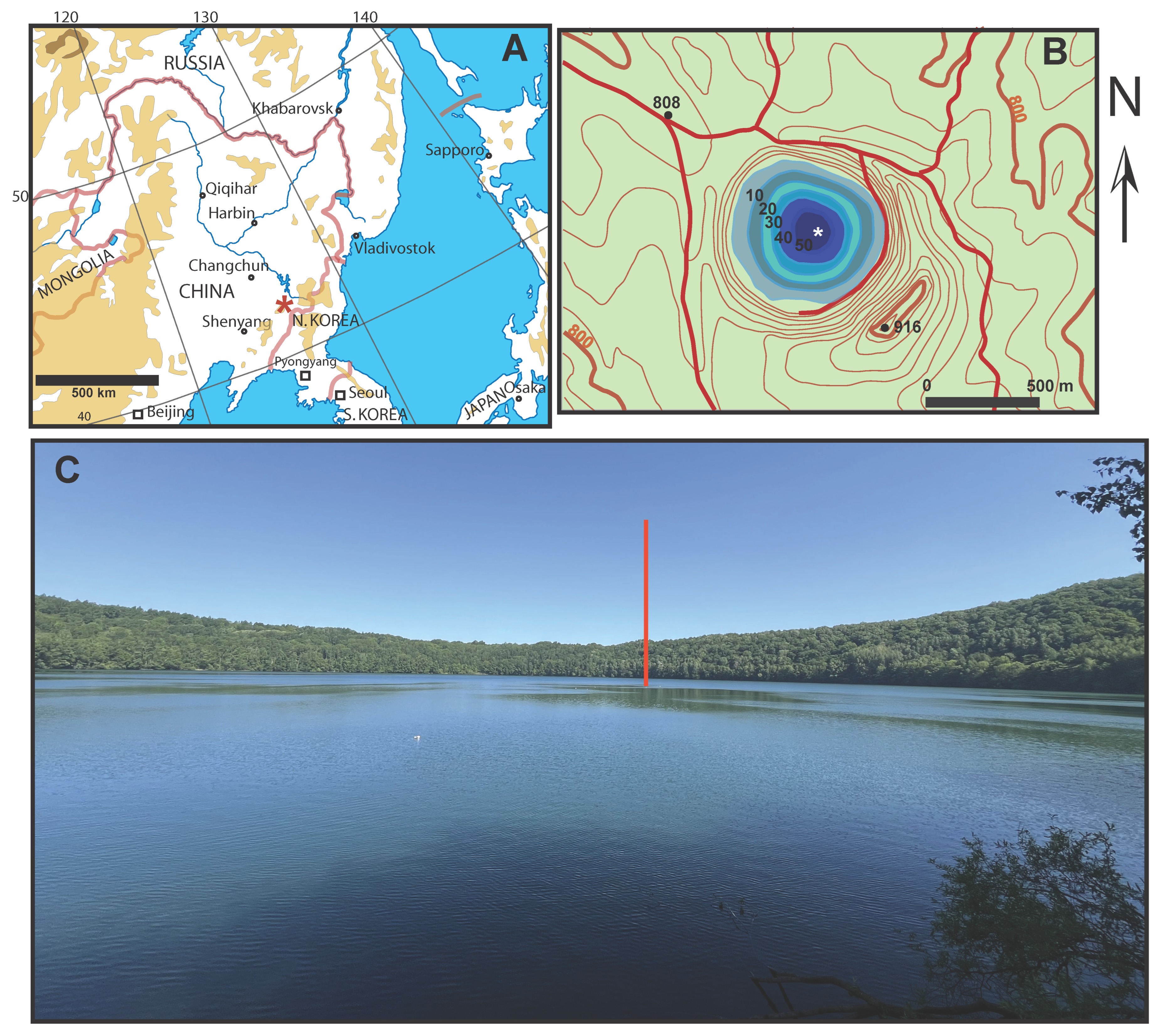
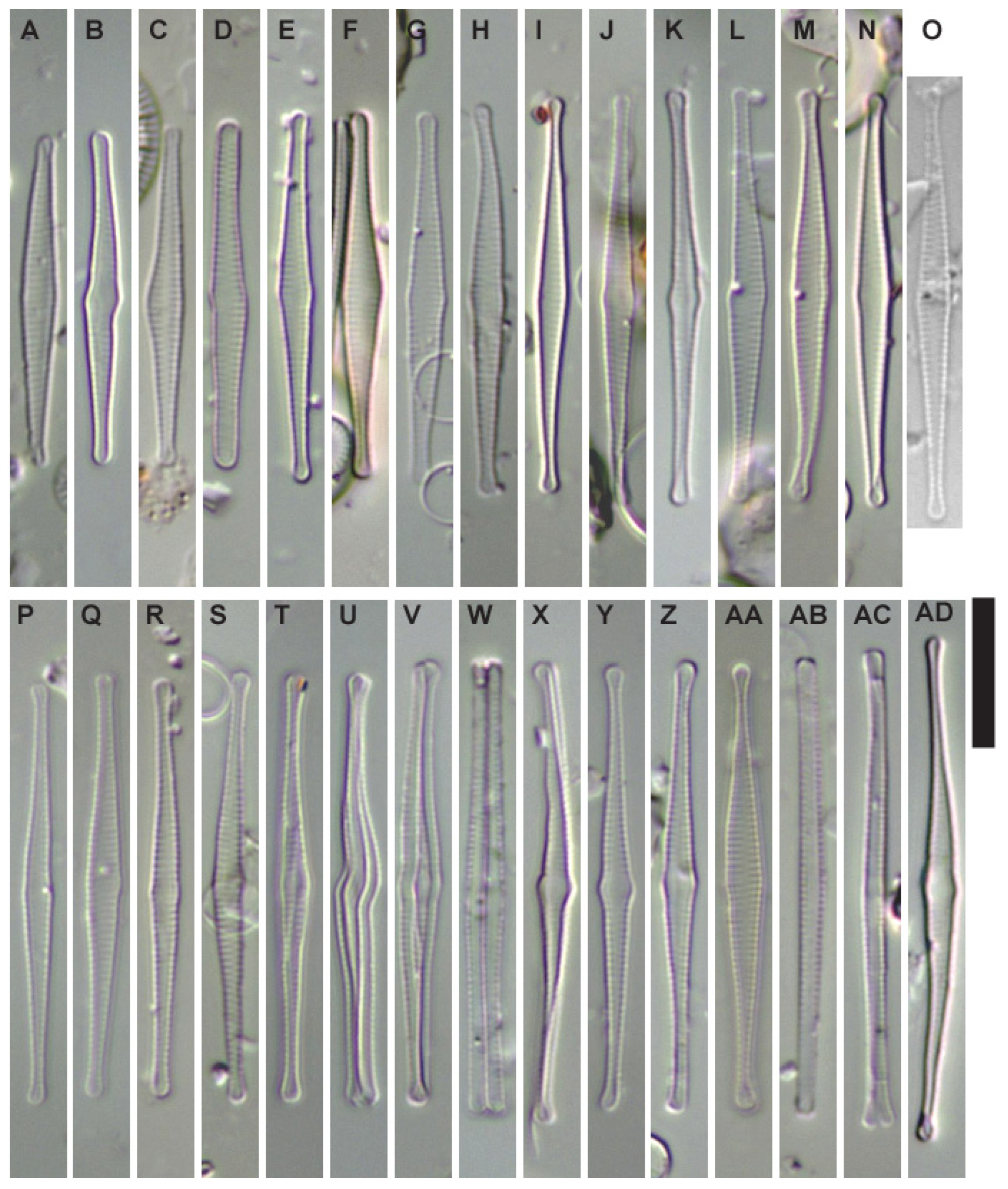

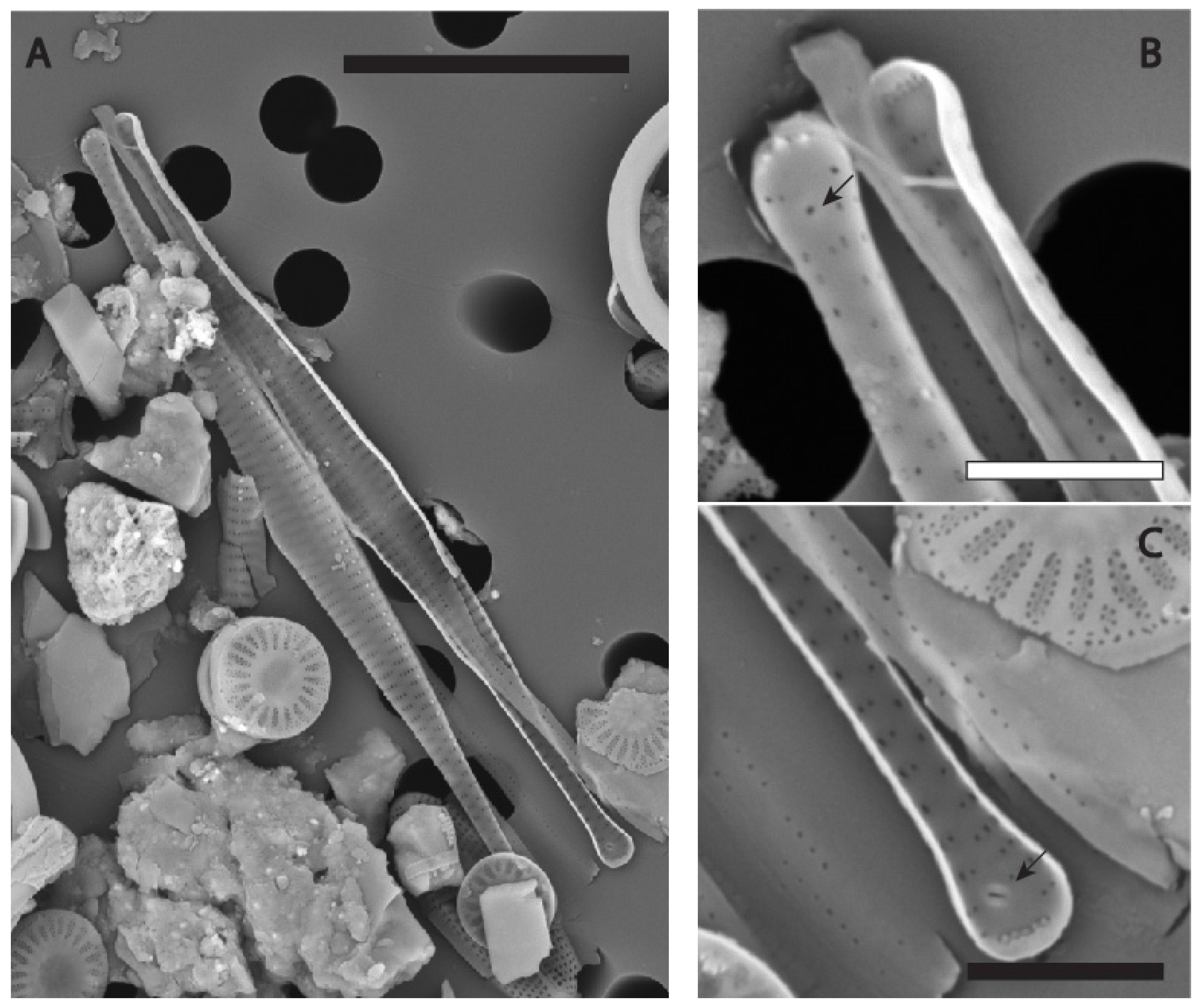

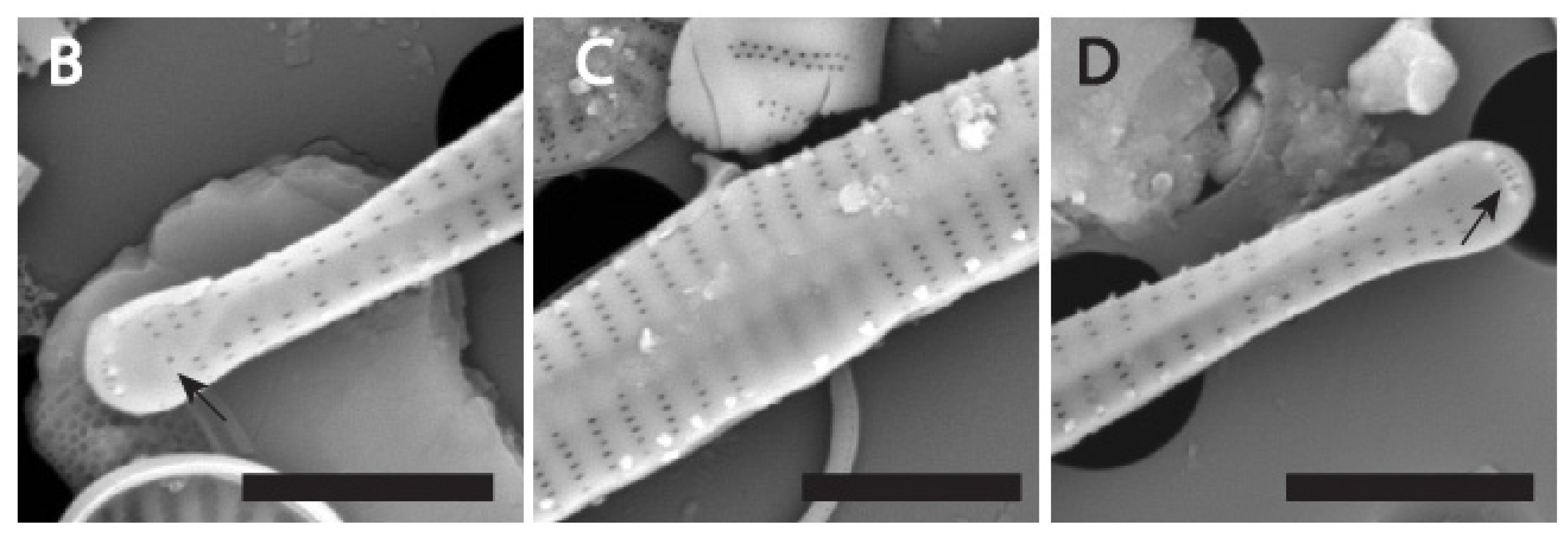
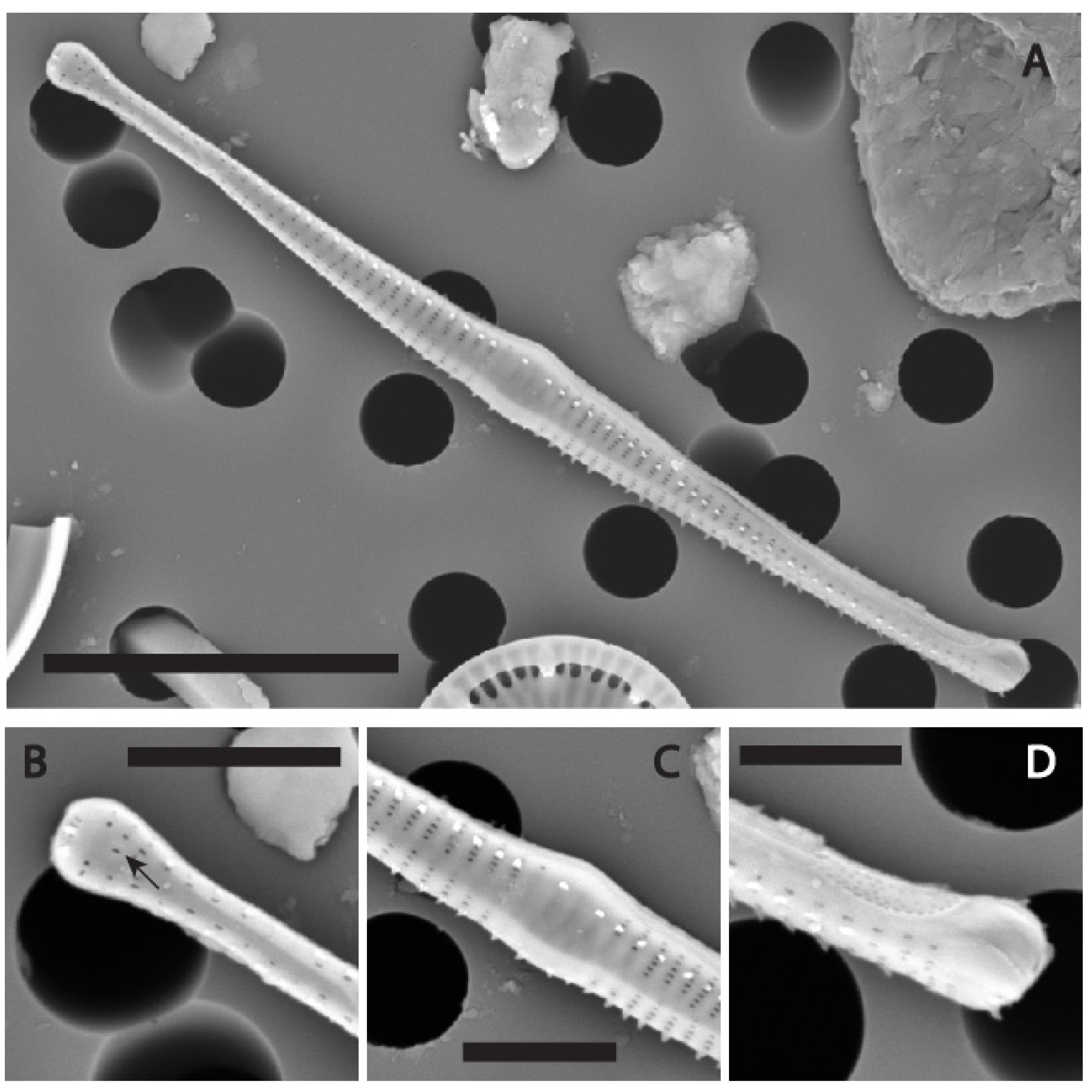

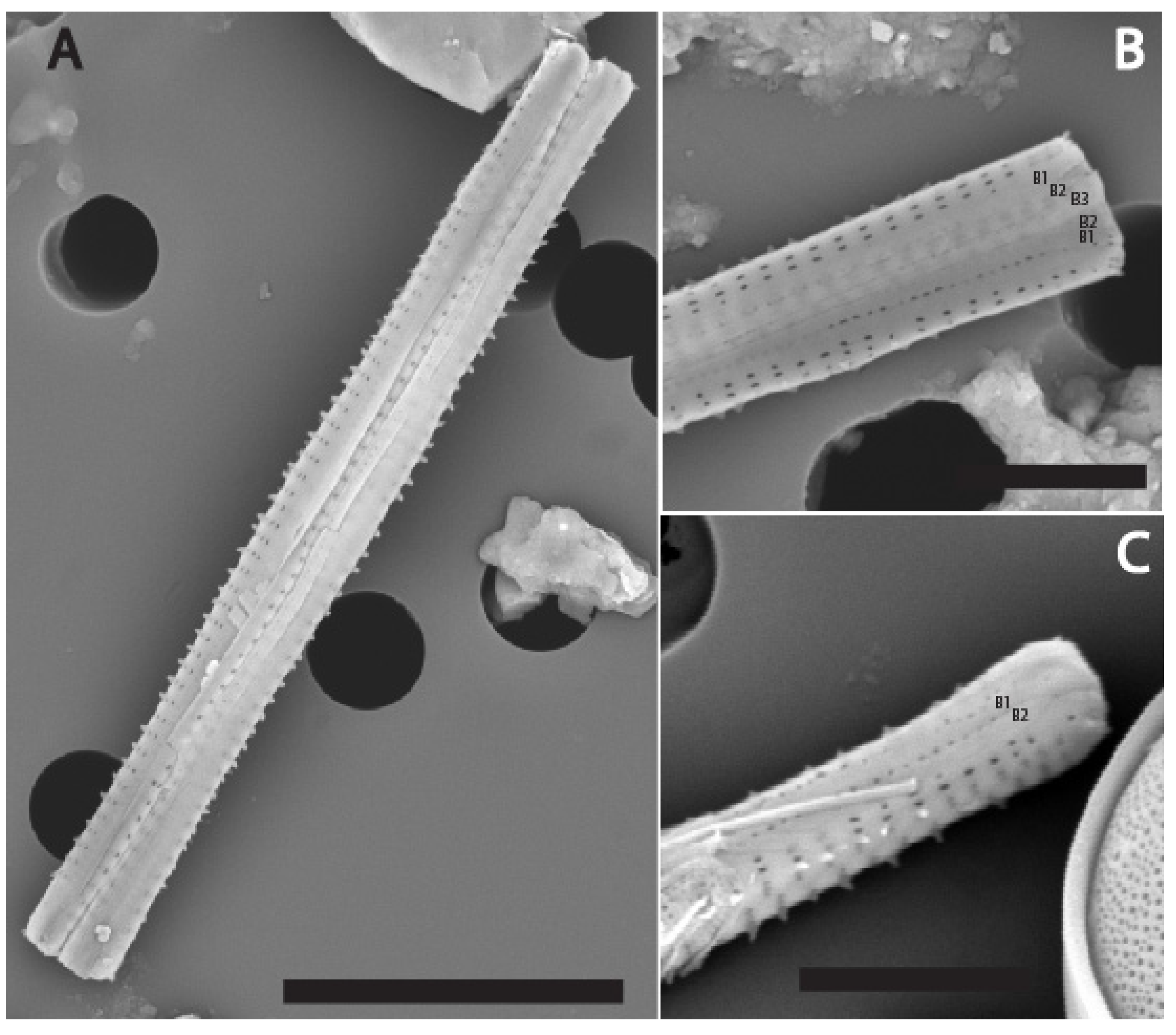

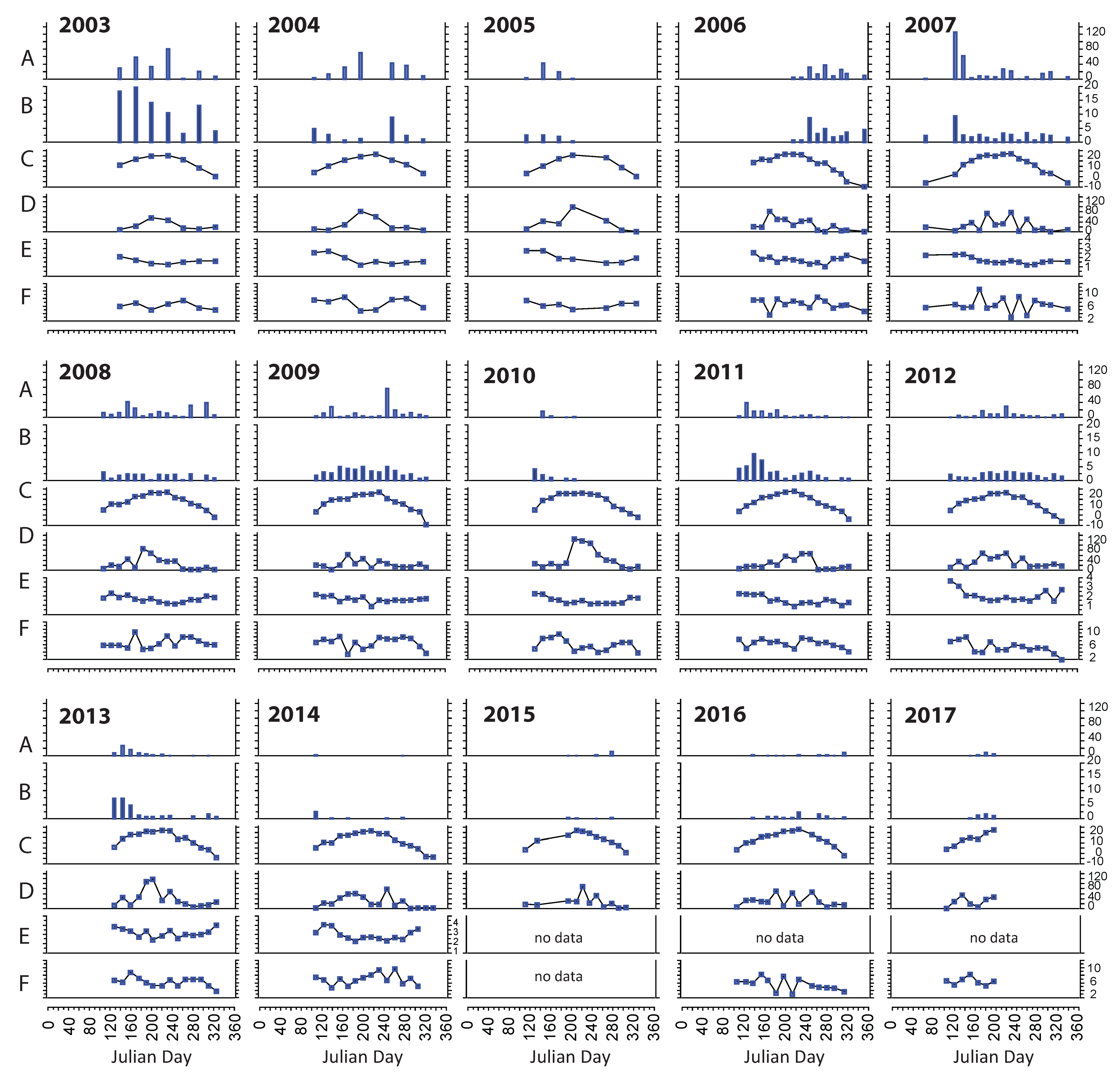
| Variable | Unit | nb | Min. | Max. | Median | St. Dev. |
|---|---|---|---|---|---|---|
| pH | 99 | 5.53 | 7.21 | 6.55 | 0.24 | |
| Elec. Conductivity | µS/L | 99 | 51 | 105 | 62 | 7 |
| Alkalinity | µeq/L | 99 | 338 | 660 | 478 | 52 |
| Tot. Phosphorus | µg/L | 99 | 5.0 | 88.6 | 14.9 | 14.4 |
| Tot. Nitrogen | µg/L | 97 | 7 | 2443 | 360 | 294 |
| Diss. Organic Carbon | mg/L | 92 | 0.2 | 10.0 | 1.7 | 1.2 |
| Cl | mg/L | 78 | 0.6 | 3.8 | 1.2 | 0.6 |
| NO3 | mg/L | 73 | 0 | 2.4 | 0.6 | 0.5 |
| SO4 | mg/L | 78 | 3.4 | 7.8 | 5.7 | 1.0 |
| Ca | mg/L | 78 | 2.7 | 28.8 | 5.3 | 5.3 |
| K | mg/L | 78 | 0.6 | 3.3 | 1.3 | 0.6 |
| Mg | mg/L | 78 | 1.2 | 3.6 | 2.3 | 0.6 |
| Na | mg/L | 78 | 1.2 | 4.4 | 2.2 | 0.7 |
| Si | mg/L | 99 | 0.1 | 0.8 | 0.4 | 0.2 |
| Secchi Disk depth | m | 22 | 2.4 | 7.6 | 3.8 | 1.3 |
| Taxon | Length (µm) | Width (µm) | Striae in 10 µm | Valve Outline | Central Area | Pore Fields | Distribution | Reference |
|---|---|---|---|---|---|---|---|---|
| F.longwania | 15–44 | 2.0–3.5 | 21–25 | spindle shaped | clearly swollen | small, only one or two rows of small poroids | Lake Sihailongwan, NE China | This study |
| F.campyla | 35–45 | 2.5–3.0 | 19–20 | linear to linear-lanceolate | not swollen | well-developed, several rows of small poroids | Europe | [3] |
| F. parva | 20–40 | 3.0–3.5 | 19–21 | linear to linear-lanceolate | swollen | well-developed, four rows of large poroids | Europe | [3] |
| F. metcalfeana | 60–120 | 2.5–3.5 | ca. 18 | linear but strongly elongated | distinctly inflated | large, 2–3 rows of large poroids | Fossil, Neogene, Dubravica, Croatia | [3] |
| F. pseudofamiliaris | 30–50 | 2.0–3.0 | 18–19 | elongated, narrowly lanceolate | not swollen | well-developed, at least four rows of small poroids | Artesian well, Dresden, Germany | [3] |
| F. scotica | 65 | 4 | 15 | linear-lanceolate | clearly inflated | not observed | Loch Leven, Scotland | [3] |
| F. nanoides | 40–90 | 1.8–2.4 | 22.5–24 | linear-lanceolate | weakly inflated | not observed | Lake Julma Ölkky, Finland | [26] |
| F.billingsii | 54–76 | 2.0–2.5 | 17–20 | narrow lanceolate | bilaterally gibbous | well-developed | Reservoir, Sao Paulo State, Brazil | [27] |
| F.huebeneri | 99–121 | 2.0–4.0 | 17–21 | spindle to needle-shaped, narrowly lanceolate | indistinct | well-developed, 3–5 rows of poroids | Lake NamCo, Tibet, China | [8] |
| F.stoermeriana | 60–110 | 1.5–3.0 | 20–24 | long, lanceolate | distinctly swollen | small ocellulimbi | Lake Superior, Ontario, Canada | [28] |
| F. tenera var. nanana | 29–85 | 2.0–2.3 | 18.5–20 | linear to linear-lanceolate | barely inflated | well-developed, three rows of poroids | cosmopolitan | [29] |
Disclaimer/Publisher’s Note: The statements, opinions and data contained in all publications are solely those of the individual author(s) and contributor(s) and not of MDPI and/or the editor(s). MDPI and/or the editor(s) disclaim responsibility for any injury to people or property resulting from any ideas, methods, instructions or products referred to in the content. |
© 2025 by the authors. Licensee MDPI, Basel, Switzerland. This article is an open access article distributed under the terms and conditions of the Creative Commons Attribution (CC BY) license (https://creativecommons.org/licenses/by/4.0/).
Share and Cite
Rioual, P.; Chu, G.; Liu, J. Fragilaria longwania sp. nov. (Bacillariophyceae), a New Araphid Diatom from Sihailongwan Maar Lake, Northeastern China. Water 2025, 17, 2843. https://doi.org/10.3390/w17192843
Rioual P, Chu G, Liu J. Fragilaria longwania sp. nov. (Bacillariophyceae), a New Araphid Diatom from Sihailongwan Maar Lake, Northeastern China. Water. 2025; 17(19):2843. https://doi.org/10.3390/w17192843
Chicago/Turabian StyleRioual, Patrick, Guoqiang Chu, and Jiaqi Liu. 2025. "Fragilaria longwania sp. nov. (Bacillariophyceae), a New Araphid Diatom from Sihailongwan Maar Lake, Northeastern China" Water 17, no. 19: 2843. https://doi.org/10.3390/w17192843
APA StyleRioual, P., Chu, G., & Liu, J. (2025). Fragilaria longwania sp. nov. (Bacillariophyceae), a New Araphid Diatom from Sihailongwan Maar Lake, Northeastern China. Water, 17(19), 2843. https://doi.org/10.3390/w17192843








